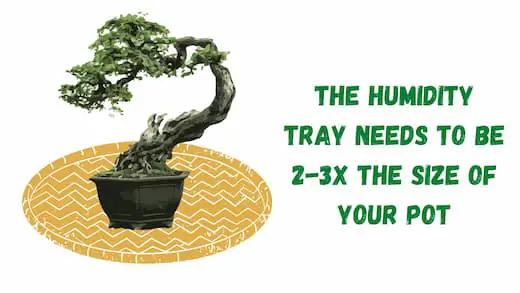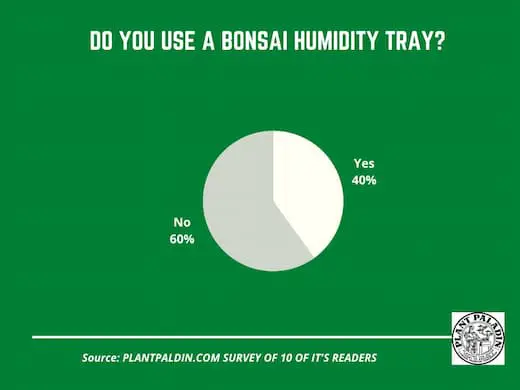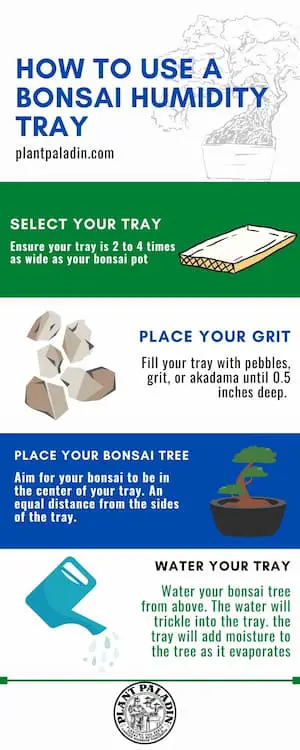This website is supported by its readers. If you click one of my links I may earn a commission. I am also a participant in the Amazon affiliates program and I will also earn a commission from qualified purchases.

So recently, I went on vacation to turkey for a week. While the trip was well deserved, I was worried about leaving my bonsai trees alone, without watering during a sweltering summer. Thankfully I came across humidity trays. However, I had one question: how to use a bonsai humidity tray.
To use a humidity tray for bonsai, fill your humidity tray with organic grit, rock, stones, gravel, or charcoal. Place your bonsai tree on the top of the tray and water your bonsai tree from above. Excess water will collect in the tray, slowly evaporating, increasing the humidity around the tray.
You must find a tray that is big enough for the size of your bonsai and its pot. Place the stones until they are about 0.5 to 1 inches high for best results.
Just a quick heads up, over the past three years of running Plantpaladin, hundreds of people have asked for product recommendations. As such, You can find my favorite indoor bonsai tree here (link takes you to Bonsaiboy), my favorite outdoor bonsai tree (link takes you to Bonsaiboy), or have a look at all the products I recommend here.
So do humidity trays work for bonsai? And are there any types of plants where this works best? Keep reading to find out more.
How to use a bonsai humidity tray
One of the most complex parts about keeping bonsai is the rare occasions you leave your trees unattended for more extended periods.
While most beginner-friendly trees such as Elms, Ficus, and Juniper trees can go without water for a few days, failing to water them for extended periods can cause underwatering, dry, dead branches, and worse case scenarios, the death of your tree.
One challenge I faced when going abroad was precisely how I would water my bonsai tree, knowing I would be away from my trees for two weeks.
As such, I got in touch with my local bonsai experts asked even asked ten plant paladin readers how they use their bonsai humidity trays.
To summarize:
- You can use humidity trays to provide moisture for your bonsai tree when you are away from your bonsai for prolonged periods.
- To use a humidity tray for your bonsai, start by measuring your tray so that it is 2 to 3 times the size of your bonsai pot.
- Then add the girt or material to your tray – stones, grit, organic rock, gravel, and charcoal all work very well for this.
- As a good rule of thumb, apply an even level of the stones or grit to the tray – typically, half an inch to an inch of coverage on the tray works best.
- Once the tray has been filled with grit, gently place your bonsai tree on top of the tray.
- Then water the bonsai using a watering can above the bonsai tree. The excess water will filter through the rocks and, over time, allow water to evaporate, adding extra moisture to your tree.
- These trays work best on species that require a lot of watering, including trees such as Willow.
- Avoid, however, using humidity trays on succulent species such as jade which are at a higher risk of overwatering.
How to use a bonsai humidity tray – quick steps
Bonsai humidity trays are a fantastic option to keep your plant full of moisture and avoid any nasty spillages that can ruin your surfaces, especially if you tend to keep your bonsai indoors as much as I do!
The four steps you need to follow to use a bonsai humidity tray are:
- Picking the right size tray
- Pouring in your material of choice
- Place your bonsai
- Pour in water
Let’s break these down.
Picking the right size tray
The first step you need to follow when using a bonsai humidity tray is to pick the right size tray.
If you pick a tray too small, your plant won’t get enough moisture or even cause the water to pool on the surface around your tray.
Pick a tray too big, and your plant might get too much water (yes, even for bonsai) and take up a lot of unnecessary room.
A good rule of thumb then is to get a tray that has about two to four times the surface area of your bonsai pot.
Just be aware that the larger your bonsai tree is, for example, an imperial-sized bonsai, the more difficult it will be to find a humidity tray for your bonsai.

As such, a humidity tray two to four times the size of your bonsai tree’s pot will mean your tree will not hold on to too much excess water but will hold enough water for a week or two of humidity.
Pour in your material of choice
Once you have your tray sorted, the next stage is to pick out the material to fill it in.
Most grit used in potting soil will work well.
For me, pebbles that you can pick up from any garden store usually work best as they are naturally waterproofed; however other items work, such as:
- Gravel
- Charcoal
- Volcanic ash rock
- Akadma
I would avoid mixing the materials, so I aim to stick to one.
Mixing multiple materials will result in an uneven distribution of grit, varying the amount of water your humidity tray will hold.
Once you have picked your material of choice, fill it in your tray right to the top.
Be careful, however, not to go over the lip of your tray.
You might find that your pebbles or gravel are a little uneven so spread your stones until you have a nice flat layer.
The exact height you will need to place the grit will vary depending on how thick your humidity tray is.
After all, the bigger the humidity tray is, the deeper you can add the grit.
As a good rule of thumb, an even layer of 0.5 to 1 inch seemed to work well for me.
Place your bonsai
Next, we have to add our bonsai.
Place your bonsai with (its plant pot) in the middle of the moisture tray.
Aim for the bonsai pot to be directly in the middle of the moisture try.
This will allow for an even moisture distribution and prevent one side of the tree from getting excess water.
If you keep the bonsai tree in a moisture tray year-round, avoid moving it too much.
Bonsai trees are notorious for small temperature changes and can be sensitive to movement so try to keep them in the tray as much as possible if this is the case.
Pour in water
Time to add some moisture to our … err… humidity tray?!
Simple enough, get cold water and pour it directly over your bonsai tree.
I’ve written a guide on watering bonsai and the best water types.
For the short version, use a watering can with a sprinkle nozzle and spray it over your bonsai tree’s leaves for about 30 seconds to a minute.
It is usual for some of the water to be absorbed between the cracks of your stone, so don’t worry if you feel you don’t have enough water.
Once you have watered the bonsai tree, the water will drip and flow between the pebbles or stones, giving a pool of water that will help add humidity to the tree as the water evaporates.
How to choose the suitable humidity tray for bonsai?
So now you know what a bonsai humidity tray is, how do you choose the right one?
There are a few essential things when it comes to choosing a suitable tray:
- Ensure that you avoid using terracotta clay pots which tend to absorb water and can drain the moisture from your humidity tray
- Ensure that the tray you use has a lip of at least 1 – 2 inches, which will help keep your water and pebbles in one place.
As such then, when making a checklist for a humidity tray, I would suggest you look for a tray that has the following:
- Is between 2 and four times the size of your bonsai pot
- Easy to clean
- Made of a lightweight easy to move material
- does not have any chemicals in the plastic/metal that can damage the tree.
Now, if you’re interested in what I recommend for a humidity tray, check out the Regal Pak (link takes you to Amazon), which is 15 inches wide so should be large enough for most bonsai that need humidifying but also comes in a three pack in case you have any accidents.

What are bonsai humidity trays?
Bonsai humidity trays are designed to provide moisture to your bonsai while simultaneously stopping any water leakage caused by watering your plant. Bonsai humidity trays are typically filled with an absorbing stone such as pebbles or charcoal to help evenly distribute moisture.
Can you avoid watering your bonsai if you use a humidity tray?
If you use a humidity tray, you must still regularly water your plant. This is because bonsai trees of all species need to be watered daily to best acclimatize to their environment and stay healthy.
Using a humidity tray is an excellent option to help keep as much moisture near your plant as possible however it is not a natural substitute for watering your plant when your topsoil is dry.
Using humidity trays and filling them up when you go abroad can be a viable option.
However, prolonged usage or underwatering of your bonsai tree will result in an unhealthy bonsai tree, so they are best only to be used as a part-time solution.
What to avoid when using bonsai humidity trays?
If you do decide to use a humidity tray to help keep moisture for your bonsai, there are a few things I would consider you avoid:
- Ensure that you use the same material in your tray to ensure even moisture is distributed throughout your plant
- It would help if you continued to water your bonsai regularly and not use the humidity tray as a substitute
- Try not to move your humidity too much – some breeds of bonsai are susceptible to the climate around them, so we must cause as minor damage as possible.
- Water the pebbles in your bonsai humidity trays regularly – the best option is to feel the pebbles,s if they feel dry, then it is time to water again – typically, once every few days works fine for most bonsai types.
Should you use bonsai humidity trays?
Bonsai humidity trays are a fantastic option that is not time-consuming to help add moisture and avoid unwanted messes when watering your bonsai.
That being said, the scientific material around the benefits of humidity trays is sketchy at best. Some studies show that the humidity provided by these is absorbed by the dry air rather than the plant itself.
I would still recommend bonsai humidity trays for a few reasons.
Firstly there are some benefits to adding extra moisture to your bonsai tree, as most bonsai need more moisture than less.
Secondly, a humidity tray has more benefits than just adding humidity, mainly absorbing any excess water your bonsai leaks after being watered.
Nothing is worse than watering your bonsai (especially if you keep your indoors) only to realize you didn’t put a tray down, and now you have soiled your best furniture (it happens to us all!)
Finally, because of the pebbles or gravel, these are more appealing to the eye than many traditional plant pots in which we keep our bonsai.
Do bonsai trees need humidity trays?
Bonsai trees do not need humidity trays and can be avoided if you water your bonsai tree regularly. Humidity trays can prove beneficial in preventing spillages and keeping the surface on which your pot is placed clean. Bonsai pots leak through holes, so humidity trays can prevent excess mess.
Do outdoor bonsai need humidity trays?
Bonsai trees kept outdoors do not need humidity trays. This is because the rainfall and moist air in most climates are usually enough for most bonsai trees outdoors. Bonsai trees planted in the ground do not need humidity trays as most organic soil naturally contains high water and moisture levels.
Benefits of using a bonsai humidity tray?
Bonsai humidity trays have several benefits, including:
- It helps keep the surface of your bonsai pot is kept on clean.
- Provides excess moisture to your tree when you are away.
- Less time-consuming than watering frequently
- It can be helpful for species that require a lot of watering, such as Willow.
What bonsai species benefit from using humidity trays?
Bonsai trees that require frequent watering will be the species that benefit the most from humidity trays. These included Willow, which typically will need watering every one to two days, even during wet conditions. Avoid using humidity trays for succulents such as jade.
I’ve put together a table below comparing several common bonsai species.
Bonsai Species | How often should topsoil be checked | Can you use a humidity tray |
Weeping Willow | A few times per day | Yes |
Birch | A few times per day | Yes |
Alder | A few times per day | Yes |
Apple | Once per day | Only if away for prolonged periods of time |
Lemon | Once per day | Only if away for prolonged periods of time |
Lime | Once per day | Only if away for prolonged periods of time |
Orange | Once per day | Only if away for prolonged periods of time |
Crabapple | Once per day | Only if away for prolonged periods of time |
Cherry | Once per day | Only if away for prolonged periods of time |
Ficus | Once per day | Only if away for prolonged periods of time |
Chinese Elm | Once per day | Only if away for prolonged periods of time |
Fukien Tea | Once per day | Only if away for prolonged periods of time |
Serissa | Once per day | Only if away for prolonged periods of time |
Olive | Once per day | Only if away for prolonged periods of time |
Juniper | Once per day | Only if away for prolonged periods of time |
Pine | Once per day | Only if away for prolonged periods of time |
Scots Pine | Once per day | Only if away for prolonged periods of time |
Oak | Once per day | Only if away for prolonged periods of time |
Jade | Once per day | Avoid |
Bonsai humidity tray – survey results
Finally, I undertook a quick survey of 10 plant paladin readers, asking if they used a humidity tray – to summarize:

My top picks for the gear you will need!
So like I mentioned earlier, over the past three years of running PlantPaladin, hundreds of people have asked me for my recommendations on the best bonsai gear on the market.
Having spent thousands of dollars on bonsai items these past few years and tested at least 100 bonsai-specific products, I’ve listed my favorite products below – All of which I highly recommend and think you can get great value.
They can purchase directly by clicking the link to take them to Amazon.
Bonsai Tool Set: One of the significant challenges I’ve had is finding a toolset that was not only durable but didn’t break the bank. SOLIGT has recently developed a fantastic bonsai tool set that covers all the tools you need to trim, prune, and repot your trees. – You can grab it here.
Complete Bonsai Set: Many of you will want to grow your bonsai trees entirely from scratch, but finding the varicose seeds, pots, and other items in one place can be challenging. Leaves and Sole then have created a complete bonsai set that I’ve personally used that ticks all the boxes. You can grab it here.
Bonsai wire: The number of times I’ve run out of wire for my bonsai or purchased cheap bonsai wire that doesn’t do the job is embarrassing for me to admit. After a lot of trial and error, I found that using Hotop’s aluminum bonsai wire is one of the best options on the market. This can easily be used for both indoor and outdoor bonsai. You can grab it here.
This post was written by Fehed Nicass who has been passionate about bonsai for over 2 years. He currently resides in the Uk and works in sales.


